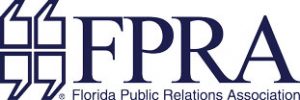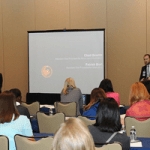Blogger: Amanda Handley, APR, Capital Chapter
As communications professionals, we literally spend our entire days working to create, send and receive messages, and Jan Spence focused her breakout session on effective strategies for both internal and external communication.
Spence began by reading an opening statement about how excited she was to be at conference, never making eye contact with the room and never pausing to take a breath. This technique underscored the importance of tone and body language when communicating. How many times have we heard “It’s not what you say but how you say it?”

- Body language: 55 percent
- Tone: 38 percent
- Words: 7 percent
Key takeaway: Communication is more than words. Be aware of this in your own communications as well as in communications with your clients (coaching can be helpful).
Spence then walked us through an exercise that demonstrated how difficult communication can be. She called for four volunteers, and each volunteer was given a role:
- Person 1: Cannot see obstacle course but must give verbal instructions to Person 2, who will be navigating an obstacle course.
- Person 2: Blindfolded so s/he cannot see obstacle course and must rely on Person 1’s instructions to navigate the course successfully.
- Person 3: Can see the course but cannot use words to communicate with Person 1. Must use nonverbal communication to give Person 1 instructions for Person 2 to follow.
- Person 4: Works to make sure Person 2 doesn’t succumb to injury as s/he navigates the course.
The course was relatively simple, only requiring Person 2 to pick up items, step around chairs, etc. However, it took several minutes to successfully navigate because of the communication limitations. But as the team worked together, Person 3 got better at communicating with Person 1. Person 1 got better at understanding Person 3’s nonverbal communication and subsequently better at giving instructions to Person 2. Finally, Person 2 got better at understanding Person 1’s instructions and was able to move more confidently through the course.
Key takeaway: It takes time to figure out how to best communicate with others. It’s not instantaneous.
After sharing statistics about the amount of time we spend each week emailing and calling and waiting on responses and call-backs, Spence moved into the meat of her presentation: how to communicate more effectively and efficiently. Doing this will have a positive impact on your business – customers, suppliers, partners, employees, clients, etc.
Spence recommends using the ARC method for communications.
- Agenda: Agree on the agenda for the communication.
- What is the time, purpose, expectation, and goal of the meeting, email, or other communication?
- Spence gave a great example of a pitfall:
- Don’t say it’ll just take “a minute” or “a second.” Nothing ever actually takes that long, so these are too vague. Instead, give a realistic expectation of time.
- Spence’s tips on agenda:
- If you’re interrupted from a task, it’s okay to ask, “Is this something that can be handled in five minutes, or should we set an appointment to talk about it further?” This communicates that you’re interested and want to give your full attention to address whatever the need is, but it also sets clear boundaries for you.
- Always open communications by giving a clear agenda. When you call someone, ask them if they have seven minutes to discuss where the group should meet, etc.
- Roles: Agree on the roles.
- Who will be in the meeting? Why
- What is the role of each person in the meeting?
- Clear Next Steps: Agree on the next steps following the communication.
- What will happen next?
- When will you meet/communicate again?
- Spence’s tip here:
- Give an RSVP deadline. When emailing to set a conference call, offer dates and times that should work, ask recipients to reply by a deadline, and tell them you will send out the conference call details.
Key takeaway: The ARC method helps you clearly communicate with others, saving you time and hassle.
To wrap up her session, Spence shared some of her pet communication tips.
PHONE – Is this the best communication method for this issue?
- Make the call prepared so that you can leave a concise voicemail message with a clear call-to-action and time frame.
- If you find yourself rambling, stop and re-record.
- Don’t be too concise by saying, “It’s Juan. Call me.” State the reason for calling.
- Repeat your phone number slowly and repeat it twice.
- Avoid phone tag by stating your availability (window of time) to receive a return call.
EMAIL – Be like a reporter – Who? What? When? Where? Why? How?
- Use spell check!
- Avoid using ALL CAPITALS; avoid overuse of words like URGENT!! Or IMPORTANT!; avoid overuse of punctuation!!!! Or emoticons. 🙂 ;P!
- Reread your email before sending. Did you follow the ARC method? Is all of the information included for the recipient to send a thorough reply?
- Use CC feature when appropriate, but think about who needs to be included.
- Be cautious of using reply-all. Know when to start a new subject thread.
- Be concise and to the point. Determine if email is the appropriate communication method or if you should use Skype, phone or text.
- Include a call-to-action – what do you want the reader to do based on the email?
- Use bullet points and separate paragraphs to make reading a longer email easier.
TEXT – Is this the best method of communication for this issue?
- Use this for short pieces of information that need to be delivered quickly.
- In most cases, a text will interrupt the person you’re sending to, so is the message urgent? Would an email be sufficient?
- Remember to sign your text message with your name as not everyone will have your phone number in their contact list.
- Even though casual text messaging language often uses “short cut” phrases, are you being professional in your approach?
- Are you clear in your request and the time frame needed for a response?
- Did you give enough information for someone to respond thoroughly?
- Don’t send a text after you’ve left a voice message unless it’s urgent.
- Double-check grammar if you are using voice-to-text to make sure the message was typed correctly.



